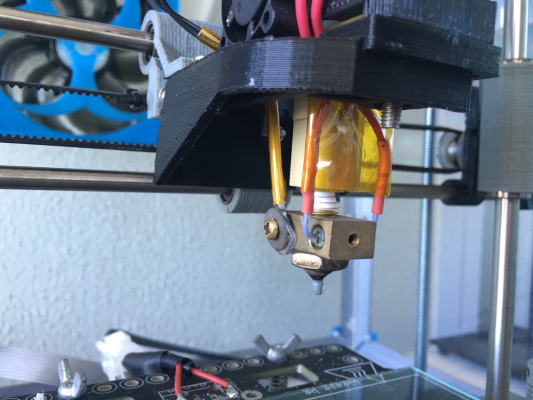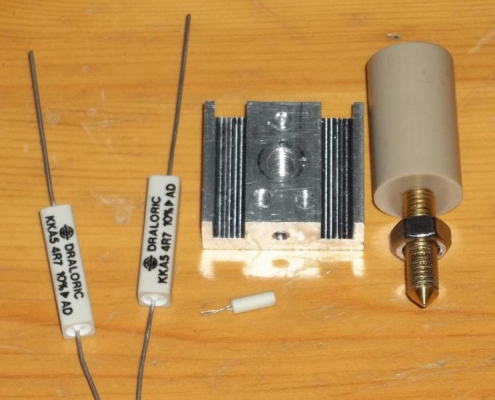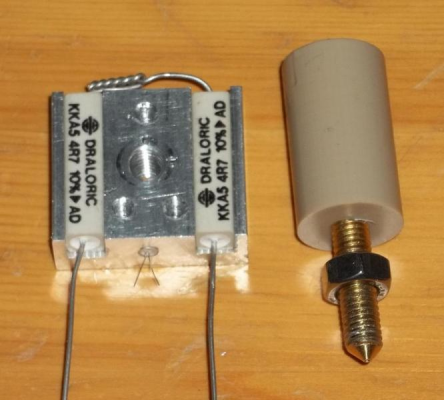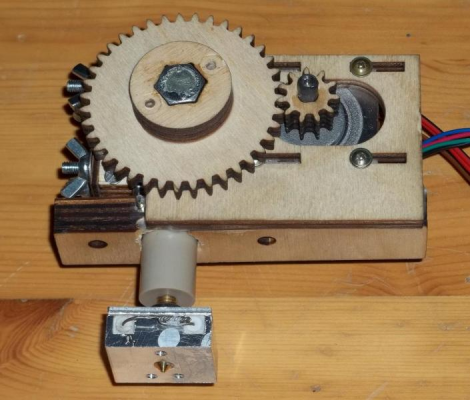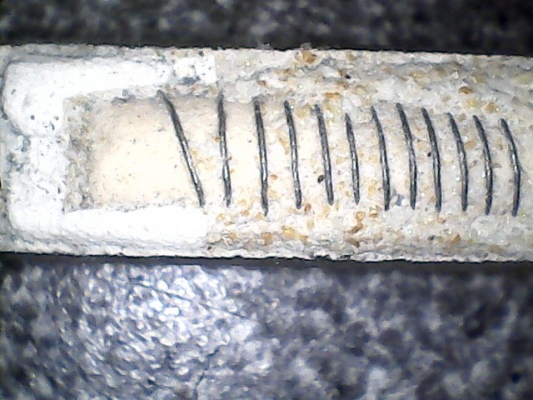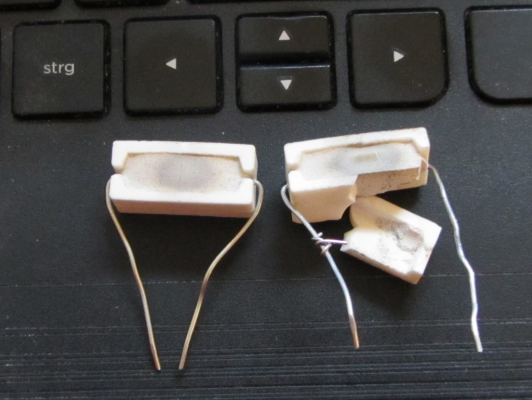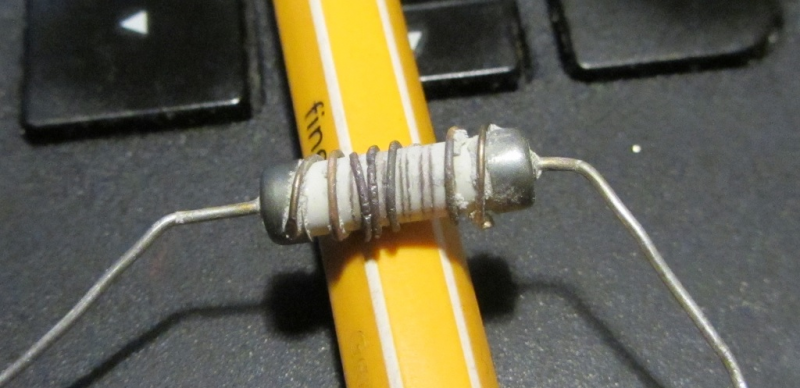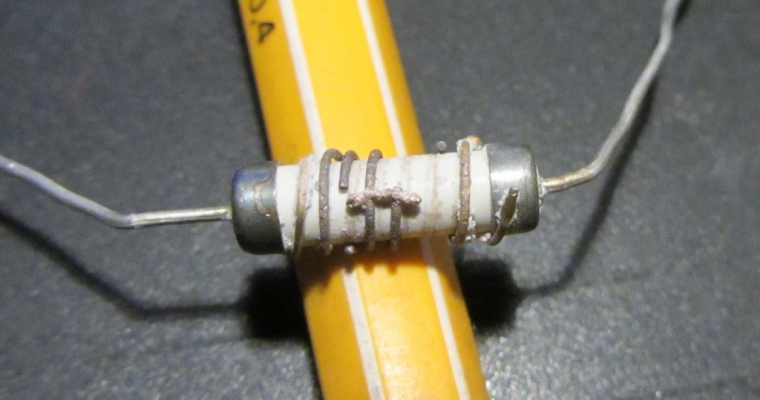Home
>
Reprappers
>
Topic
Is this resistor suitable as a heater for the hot-end?
Posted by qrp-gaijin
|
Is this resistor suitable as a heater for the hot-end? March 30, 2021 10:43AM |
Registered: 3 years ago Posts: 93 |
My hot end is no longer heating up properly and I suspect a worn-out heater. My heater block seems to require a heater of about 4.5 mm or smaller diameter, but modern ceramic heaters seem to be 6 mm in diameter. My current heating element is a wire-wound resistor about 4.4 mm in diameter.
Here is a picture (not mine) of the heater block.
[www.igorkromin.net]
I found the following resistor at a local supplier. Would it be suitable?
RS01A5R000FE12
[www.mouser.com]
Key specifications:
The first thing is that the diameter is smaller than my current heater resistor, meaning it will fit somewhat loosely inside of the hole designed for the heating element. On the other hand, my heater block contains a set screw intended to press the body of the resistor against the inside wall of the accommodating hole in the heater block. Is a loosely-fitting heater resistor acceptable in this application?
Any other concerns?
Here is a picture (not mine) of the heater block.
[www.igorkromin.net]
I found the following resistor at a local supplier. Would it be suitable?
RS01A5R000FE12
[www.mouser.com]
Key specifications:
- Wirewound Resistor
- 5 ohms
- 1 Watt
- Diameter: [2.39 ± 0.787] mm
- Operating Temperature Range°C: Characteristic U = -65 to +250, characteristic V = -65 to +350
- High Temperature Exposure: 250 h at: U = +250 °C, V = +350 °C
The first thing is that the diameter is smaller than my current heater resistor, meaning it will fit somewhat loosely inside of the hole designed for the heating element. On the other hand, my heater block contains a set screw intended to press the body of the resistor against the inside wall of the accommodating hole in the heater block. Is a loosely-fitting heater resistor acceptable in this application?
Any other concerns?
|
Re: Is this resistor suitable as a heater for the hot-end? March 30, 2021 10:48AM |
Registered: 11 years ago Posts: 5,780 |
The heater block is aluminum. You could drill it out to 6mm in about 3 seconds with a hand drill.
Ultra MegaMax Dominator 3D printer: [drmrehorst.blogspot.com]
Ultra MegaMax Dominator 3D printer: [drmrehorst.blogspot.com]
|
Re: Is this resistor suitable as a heater for the hot-end? March 30, 2021 02:58PM |
Registered: 12 years ago Posts: 1,450 |
In this particular case, I would advise that it is not a good choice and very likely to fail. I say this despite the fact that I use a 3W resistor and pass 30 watts through it, the composition of that resistor is glass enamel, aluminium oxide/silica ceramic, and nichrome wires - all materials which would be the chosen ones to run at the sort of temperatures. Most importantly, I have taken great care to get good thermal coupling from the resistor to the hotend body with close-fitting and a very high grade of thermal compound. Despite this, I have had one fail under test in only 80 hours of use - probably caused by local hot spots where the nichrome elements are spot welded the steel end caps.
In your case, you are asking for a 1W resistor with silicone insulation, rated at 350°C at most, to perform the same function, and with a loose fit of the resistor to the hotend body. My guess is that the failure will be in minutes rather than hours. If you can, go for a heater cartridge. If not, then try using a Vishay Sfernice RWM4X10 resistor, selecting one with a thin even enamel coating. Bore the hole in the hotend block to very closely fit the resistor and then used Slice engineering Boron Nitride hotend compound. It should work but your mileage may vary - my long-term tests are not completed yet.
Mike
In your case, you are asking for a 1W resistor with silicone insulation, rated at 350°C at most, to perform the same function, and with a loose fit of the resistor to the hotend body. My guess is that the failure will be in minutes rather than hours. If you can, go for a heater cartridge. If not, then try using a Vishay Sfernice RWM4X10 resistor, selecting one with a thin even enamel coating. Bore the hole in the hotend block to very closely fit the resistor and then used Slice engineering Boron Nitride hotend compound. It should work but your mileage may vary - my long-term tests are not completed yet.
Mike
|
Re: Is this resistor suitable as a heater for the hot-end? March 31, 2021 11:03AM |
Registered: 6 years ago Posts: 1,863 |
|
Re: Is this resistor suitable as a heater for the hot-end? March 31, 2021 12:07PM |
Registered: 3 years ago Posts: 93 |
Quote
the_digital_dentist
The heater block is aluminum. You could drill it out to 6mm in about 3 seconds with a hand drill.
For various reasons that's unfortunately not feasible for me at the moment.
If I can find a local supplier that supplies an appropriately-sized, appropriately-rated wire-wound resistor, I'll use that.
Otherwise, I think I'll buy a new heater block and nozzle, that will fit a 6 mm ceramic heater, and rebuild the hot end completely. This is going to be an interesting challenge as I've never built a hot end from scratch before. I also need it to support 3 mm filament, which may be difficult since such parts are more difficult to source these days.
Eventually I plan to replace the 3 mm hot end with a more modern 1.75 mm hot end, but for now I want to use up my old 3 mm filament first.
|
Re: Is this resistor suitable as a heater for the hot-end? April 04, 2021 12:07AM |
Registered: 3 years ago Posts: 93 |
A 2014 discussion seemed to conclude that a wire-wound resistor could be safer because it likely cannot reach the high temperatures that a ceramic heater could, meaning that in case of thermal runaway, a resistor would be less likely to cause a fire: [reprap.org] . Another 2014 post indicated that a 20W ceramic heater cartridge should self-limit itself to 300 degrees Celsius, reducing the possibility of a fire: [reprap.org] . Unfortunately, all of the ceramic heaters I could find locally are in the 30W-50W range, which makes me think they could be prone to over-heating.
After some more searching, I found a local supplier with better resistors: 3 watt, 5 ohm, 4.7 mm diameter, wire-wound resistors, which should fit my existing heater block (with a 5 mm diameter chamber for the heater) snugly. These are still silicone-coated resistors, but one user has indicated at this link that silicone-coated resistors had been used successfully: [reprap.org] . I think I'll give these a try, possibly wrapping in aluminium foil (as recommended at the link above) to increase thermal conductivity with the heater block. Anyway, they're cheap, and failure will likely burn out only the resistor, not anything else.
After some more searching, I found a local supplier with better resistors: 3 watt, 5 ohm, 4.7 mm diameter, wire-wound resistors, which should fit my existing heater block (with a 5 mm diameter chamber for the heater) snugly. These are still silicone-coated resistors, but one user has indicated at this link that silicone-coated resistors had been used successfully: [reprap.org] . I think I'll give these a try, possibly wrapping in aluminium foil (as recommended at the link above) to increase thermal conductivity with the heater block. Anyway, they're cheap, and failure will likely burn out only the resistor, not anything else.
|
Re: Is this resistor suitable as a heater for the hot-end? April 10, 2021 04:49AM |
Registered: 3 years ago Posts: 93 |
This 3 watt, 5 ohm, 4.7 mm diameter, silicone-coated, wire-wound resistor (Vishay RS series, RS02B5R000FE12) has been working fine for a couple of hours now:
[www.mouser.com]
Image: [www.newark.com]
I wrapped a bit of aluminium foil around the center of the resistor to make it fit the 5 mm-diameter heater block more snugly and lightly adjusted the set screw to push the resistor against the inside wall of the heater block. When I first fired it up there was a bit of smoke and odd odor as "something" burned off, but after the initial bit of smoke, the resistor seems to be doing fine now as a heater, and it heats up quickly in less than a minute. Good enough for me!
Edited 2 time(s). Last edit at 04/10/2021 04:56AM by qrp-gaijin.
[www.mouser.com]
Image: [www.newark.com]
I wrapped a bit of aluminium foil around the center of the resistor to make it fit the 5 mm-diameter heater block more snugly and lightly adjusted the set screw to push the resistor against the inside wall of the heater block. When I first fired it up there was a bit of smoke and odd odor as "something" burned off, but after the initial bit of smoke, the resistor seems to be doing fine now as a heater, and it heats up quickly in less than a minute. Good enough for me!

Edited 2 time(s). Last edit at 04/10/2021 04:56AM by qrp-gaijin.
|
Re: Is this resistor suitable as a heater for the hot-end? April 10, 2021 06:19AM |
Admin Registered: 16 years ago Posts: 13,886 |
... in the beginning I've built a heater block out of aluminium with two 4,7Ohm/5Watt resisitors in series, clamped into two milled "pockets" and a PT100 as temp-sensor -- worked really good with heating powers of up to 100 Watts 
Edited 2 time(s). Last edit at 04/10/2021 11:13AM by VDX.
Viktor
--------
Aufruf zum Projekt "Müll-freie Meere" - [reprap.org] -- Deutsche Facebook-Gruppe - [www.facebook.com]
Call for the project "garbage-free seas" - [reprap.org]

Edited 2 time(s). Last edit at 04/10/2021 11:13AM by VDX.
Viktor
--------
Aufruf zum Projekt "Müll-freie Meere" - [reprap.org] -- Deutsche Facebook-Gruppe - [www.facebook.com]
Call for the project "garbage-free seas" - [reprap.org]
|
Re: Is this resistor suitable as a heater for the hot-end? April 10, 2021 06:56AM |
Registered: 12 years ago Posts: 1,450 |
I was quite intrigued by your link to the earlier discussion back in 2014 [reprap.org] where nophead recommends a 3W 6.8 Ohm resistor, Vishay RWM04106R80JR15E1. I have been using 7W resistors without failure since my first 3D printer but had only recently, and with great trepidation, tried 3W resistors.
I will be interested in how well your silicone resistor holds up although I am a little skeptical as the vitreous enamel ones can be driven to a red heat for some time before failing but I don't think that the outer insulation on a silicone one would take it as well.
In the end though, the glorious perfection (or otherwise) of the vitreous enamel wire-wound resistor is moot as they are no longer being made. The exact one that nophead liked is available [uk.farnell.com] but only 793 are left.
Mike
I will be interested in how well your silicone resistor holds up although I am a little skeptical as the vitreous enamel ones can be driven to a red heat for some time before failing but I don't think that the outer insulation on a silicone one would take it as well.
In the end though, the glorious perfection (or otherwise) of the vitreous enamel wire-wound resistor is moot as they are no longer being made. The exact one that nophead liked is available [uk.farnell.com] but only 793 are left.
Mike
|
Re: Is this resistor suitable as a heater for the hot-end? April 10, 2021 11:13AM |
Admin Registered: 16 years ago Posts: 13,886 |
... I've found the images from my old "double-resistors"-hotend - this are 5watt-resistors, but capable of heating from ambient to 300degC in some ten seconds! 
Viktor
--------
Aufruf zum Projekt "Müll-freie Meere" - [reprap.org] -- Deutsche Facebook-Gruppe - [www.facebook.com]
Call for the project "garbage-free seas" - [reprap.org]

Viktor
--------
Aufruf zum Projekt "Müll-freie Meere" - [reprap.org] -- Deutsche Facebook-Gruppe - [www.facebook.com]
Call for the project "garbage-free seas" - [reprap.org]
|
Re: Is this resistor suitable as a heater for the hot-end? April 10, 2021 03:44PM |
Registered: 12 years ago Posts: 1,450 |
I was an early adopter of heater cartridges and abandoned them when the majority of those I purchased turned out to be faulty. I would think that they have improved considerably since the ones that I purchased, but that is no reason to change from resistors to cartridges as long as resistors remain reliable - which they have.
I do have some of the original cartridges that were within spec. Those more than 20% out of tolerance - and there were many, along with shorts to the case, etc., were binned. I cut one of the remaining ones open to view it and am now even more strongly of the opinion that these were designed and made by unskilled labour. As evidence, I submit these photos of the inner parts of the one I cut open.
Notice that the winding does not have the sort of regularity that you would expect if it was automated. The ceramic also seems quite strange as it seems to have grains of beach sand in a matrix of what appears to be gypsum (plaster of paris). The core seems to be made of the same material as the packing but both ends are filled with the "gypsum" without sand additives.
This brings us to the matter of the wire. In another thread, I was asked
Mike
I do have some of the original cartridges that were within spec. Those more than 20% out of tolerance - and there were many, along with shorts to the case, etc., were binned. I cut one of the remaining ones open to view it and am now even more strongly of the opinion that these were designed and made by unskilled labour. As evidence, I submit these photos of the inner parts of the one I cut open.
Notice that the winding does not have the sort of regularity that you would expect if it was automated. The ceramic also seems quite strange as it seems to have grains of beach sand in a matrix of what appears to be gypsum (plaster of paris). The core seems to be made of the same material as the packing but both ends are filled with the "gypsum" without sand additives.
This brings us to the matter of the wire. In another thread, I was asked
Well, yes actually. Ignoring the 30W resistor which is a red herring, a 3W resistor will use about the same length and diameter of nichrome wire as a 30W cartridge heater.Quote
................. Let's consider the construction of wire-wound resistors for a moment. Do you think a 3W resistor uses the same diameter nichrome wire that a 30W resistor (or a 30W heater cartridge) .....................
Mike
|
Re: Is this resistor suitable as a heater for the hot-end? April 10, 2021 05:17PM |
Admin Registered: 16 years ago Posts: 13,886 |
... I've managed to "explode" another type 5W-resistors by excessive overcurrent, so the wires evaporated partially - this are the images of the remains:
Viktor
--------
Aufruf zum Projekt "Müll-freie Meere" - [reprap.org] -- Deutsche Facebook-Gruppe - [www.facebook.com]
Call for the project "garbage-free seas" - [reprap.org]
Viktor
--------
Aufruf zum Projekt "Müll-freie Meere" - [reprap.org] -- Deutsche Facebook-Gruppe - [www.facebook.com]
Call for the project "garbage-free seas" - [reprap.org]
|
Re: Is this resistor suitable as a heater for the hot-end? April 10, 2021 10:32PM |
Registered: 3 years ago Posts: 93 |
Quote
leadinglights
I will be interested in how well your silicone resistor holds up although I am a little skeptical as the vitreous enamel ones can be driven to a red heat for some time before failing but I don't think that the outer insulation on a silicone one would take it as well.
According to the datasheet, there are two types of resistors: type U and type V. Type U can supposedly withstand +250 degrees C for 250 hours; type V can withstand +350 degrees C for 250 hours. So a conservative estimate would be failure after 250 hours. At my current rate of printing (maybe max. 25 hours/week) that means the resistor might fail 10 weeks from now.
But I'm not running the resistor at 250 degrees C; I usually run it around 180 degrees. There is some "power derating vs. temperature" graph in the datasheet, but it's not clear to me how to translate the power derating into a lifetime derating. Anyway, since I don't use the printer heavily, I expect the resistor will last long enough so that I will eventually just stop worrying about it.
There are many other breakable (or breaking, or already broken...) parts on the printer that will likely give me problems long before the resistor does.

|
Re: Is this resistor suitable as a heater for the hot-end? April 11, 2021 02:40AM |
Registered: 9 years ago Posts: 483 |
Hmmm. [www.aliexpress.com]
|
Re: Is this resistor suitable as a heater for the hot-end? May 05, 2021 09:51AM |
Registered: 3 years ago Posts: 93 |
Quote
leadinglights
I will be interested in how well your silicone resistor holds up although I am a little skeptical as the vitreous enamel ones can be driven to a red heat for some time before failing but I don't think that the outer insulation on a silicone one would take it as well.
For the past few days the hot end has been unable to maintain a steady 180 degree temperature. It climbs to around 170 or so then dips down and up, even dipping down when the heater current is fully on. I assume the cause is is either that the set screw (that presses the resistor, which I wrapped in aluminium foil, against the inner wall of the heater block) has become loose, or that the resistor has started to fail.
I just measured the resistance across the resistor and it was 10 ohms, but after physically poking the resistor body, it's now reading a more nominal 6 ohms. Perhaps the resistor is starting to physically disintegrate, and my poking of the resistor temporarily caused it to revert to a nominally functioning state.
I'll be interested in pulling out the resistor and checking its physical integrity.
|
Re: Is this resistor suitable as a heater for the hot-end? May 05, 2021 02:30PM |
Registered: 12 years ago Posts: 1,450 |
The most likely area where it will have become intermittent is where the nichrome wire is spot welded onto the end caps. On older vitreous resistors the end cap is a nickel steel alloy (on Vishay-Sfernice resistors) and this welds cleanly with the nichrome - the temperature can be cycled repeatedly without the weld failing. On the newer silicone resistors, the end caps are carbon steel which is fine as long as the temperature is less than 250 degrees but the weld becomes brittle if it is cycled above this temperature. This is not the only problem with the silicone ones as they can become hot enough to turn the silicone into a powder even if the hot-end itself is below 250 degrees If this happens then you may get a short circuit from both caps to the hot-end body at the same time.
For simplicity, and because life is too short to argue, I think that you should use a heater cartridge. For myself, having done a lot of research I think that the Vishay vitreous resistors are pretty much as good as heater cartridges and are a more useful size for my requirement.
Mike
For simplicity, and because life is too short to argue, I think that you should use a heater cartridge. For myself, having done a lot of research I think that the Vishay vitreous resistors are pretty much as good as heater cartridges and are a more useful size for my requirement.
Mike
|
Re: Is this resistor suitable as a heater for the hot-end? May 05, 2021 09:10PM |
Registered: 3 years ago Posts: 93 |
Quote
leadinglights
For simplicity, and because life is too short to argue, I think that you should use a heater cartridge.
In true RepRap fashion, I plan to use the printer to upgrade itself. I have four more resistors on hand that fit my current heater block. I can swap out the faulty resistor with a new one, and I guess a new one should last for maybe 20-30 hours of printing.
Then, I can buy a new hot end -- that, unlike my current hot end, will be large enough to accommodate a ceramic heater cartridge -- and at the same time switch to 1.75 mm filament.
To accommodate the new shape of the hot end, I can use my old 3 mm hot end with the heater resistor to print out a few iterations of a new plastic mounting bracket that will fit the new hot end.
|
Re: Is this resistor suitable as a heater for the hot-end? May 08, 2021 06:55AM |
Registered: 3 years ago Posts: 93 |
Thinking back on the behavior of the printer just before the resistor started to fail, I may have noticed a behavior that was indicative of the impending failure: occasional large sinusoidal temperature swings (with period of a few seconds) during printing.
When I first installed the resistor, it worked quite fine without any PID tuning and held the temperature well. But some hours (measured in printing time) before failure, the temperature was occasionally swinging up and down by 5-10 degrees, above and below the target temperature. Perhaps what happens in the early stages of failure is that the spot-welded contact becomes intermittent; the temperature starts to drop; to compensate, the PID controller dumps more current into the heater; the contact temporarily recovers; the current inrush causes overshooting the target temperature; the PID controller slowly compensates back to the target temperature. The temperature then stays steady, until the next time that the contact suddenly becomes intermittent, which causes another sudden drop followed by another sudden overcompensation.
An unproven theory, but perhaps of use in early detection of failure. I now have my new V6-clone hot end (with ceramic heater) and am planning on migrating to that, but to do that migration, I will need to continue to using resistive heating with my current hot end to print the new parts. Therefore, I still plan on using a heater resistor at least one more time, until the new resistor fails. I will be on the lookout to see if the above cyclic temperature variations again occur shortly before failure.
Edited 1 time(s). Last edit at 05/08/2021 06:58AM by qrp-gaijin.
When I first installed the resistor, it worked quite fine without any PID tuning and held the temperature well. But some hours (measured in printing time) before failure, the temperature was occasionally swinging up and down by 5-10 degrees, above and below the target temperature. Perhaps what happens in the early stages of failure is that the spot-welded contact becomes intermittent; the temperature starts to drop; to compensate, the PID controller dumps more current into the heater; the contact temporarily recovers; the current inrush causes overshooting the target temperature; the PID controller slowly compensates back to the target temperature. The temperature then stays steady, until the next time that the contact suddenly becomes intermittent, which causes another sudden drop followed by another sudden overcompensation.
An unproven theory, but perhaps of use in early detection of failure. I now have my new V6-clone hot end (with ceramic heater) and am planning on migrating to that, but to do that migration, I will need to continue to using resistive heating with my current hot end to print the new parts. Therefore, I still plan on using a heater resistor at least one more time, until the new resistor fails. I will be on the lookout to see if the above cyclic temperature variations again occur shortly before failure.
Edited 1 time(s). Last edit at 05/08/2021 06:58AM by qrp-gaijin.
|
Re: Is this resistor suitable as a heater for the hot-end? May 08, 2021 09:29AM |
Registered: 12 years ago Posts: 1,450 |
Using some component or product for a purpose for which it was not designed does have several problems. You may find that a resistor might be better heater than a purpose made cartridge; but that does not mean that similar resistors are as good. This is a problem with other parts as well and many examples are found in the RepRap printers:-
An M8 threaded rod made for the building industry will typically be nearly as accurate as a purpose-made lead screw. There is, however nothing you could complain about if it is not accurate as long as it would serve its design purpose in the building industry.
Nail varnish remover is typically pure acetone, but it may contain no acetone but have ethyl acetate, glycerine, isopropyl alcohol, d-limonene as well as perfumes, and lanolin oil. All useless for cleaning print surfaces or vapour polishing ABS prints.
Some brands of hairspray used to hold a print to a print surface may work well, but others have about the same holding power as Vasolene. This is similar to a problem where off-road rally drivers would spray their ignitions systems with a famous hairspray for added waterproofing - until the recipe of the hairspray was changed and it was neither an insulator nor very waterproof.
Power supplies taken from computers and used in RepRap printers can vary widely in their specification - despite sometimes having only slightly different model numbers. This can be dangerous to the unwary - such as some having the power switch on the mains input and others where the mains switch is on a 5V line.
Mike
An M8 threaded rod made for the building industry will typically be nearly as accurate as a purpose-made lead screw. There is, however nothing you could complain about if it is not accurate as long as it would serve its design purpose in the building industry.
Nail varnish remover is typically pure acetone, but it may contain no acetone but have ethyl acetate, glycerine, isopropyl alcohol, d-limonene as well as perfumes, and lanolin oil. All useless for cleaning print surfaces or vapour polishing ABS prints.
Some brands of hairspray used to hold a print to a print surface may work well, but others have about the same holding power as Vasolene. This is similar to a problem where off-road rally drivers would spray their ignitions systems with a famous hairspray for added waterproofing - until the recipe of the hairspray was changed and it was neither an insulator nor very waterproof.
Power supplies taken from computers and used in RepRap printers can vary widely in their specification - despite sometimes having only slightly different model numbers. This can be dangerous to the unwary - such as some having the power switch on the mains input and others where the mains switch is on a 5V line.
Mike
Sorry, only registered users may post in this forum.
